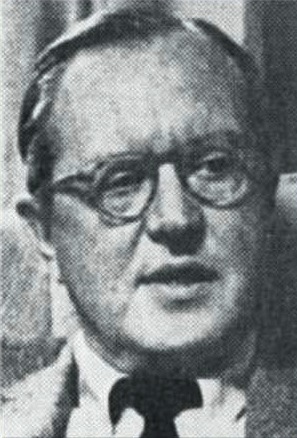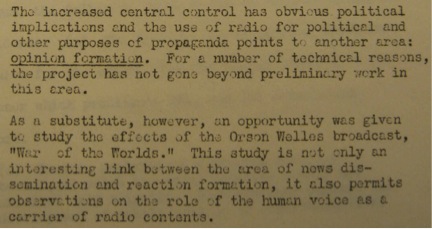From Mercury to Mars: War of the Worlds and the Invasion of Media Studies
“One may picture, too, the sudden shifting of the attention…” – H.G. Wells, War of the Worlds (1898)
Hadley Cantril, Educational Radio, and The Princeton Radio Research Project
What was the effect of The Mercury Theatre on the Air’s 1938 “War of the Worlds” (WOTW) broadcast on Communication and Media Studies? Besides being one of the seminal works of Mass Media history, WOTW turns out to be the subject of the first major commissioned analysis of audience reception that helped to legitimate the reliability of public policy research. The name of that influential study was The Invasion from Mars: A Study in the Psychology of Panic, written by Hadley Cantril and first published by Princeton University Press in 1940. How Cantril’s book came to be commissioned is almost as central to the history of media research as the program itself.
The back story actually begins with the problems faced by educational broadcasters in the 1930s, the forerunner to public broadcasting in the U.S. Before 1934 there was a robust experiment in public pedagogy run out of universities and school districts, but the Communications Act of 1934 privatized the use of radio so extensively that only about two-dozen stations remained. One of the reasons this happened was because there was no evidence that educational radio was in fact educational. But after 1934, FCC commissioners E.O. Sykes and Anning Prall were interested in classroom extension services via radio, if research could show that educational technology was a viable use of frequency allocations.
In 1935 the FCC formed an exploratory commission with the Office of Education to examine this question, called the Federal Radio Education Committee (FREC). Princeton psychologist Hadley Cantril was designated by the FREC to supervise a special study on audience reception. He obtained funds from the Rockefeller Foundation and received support from William Paley of CBS through the appointment of a young CBS researcher named Frank Stanton. Cantril also recruited a young Austrian immigrant named Paul Lazarsfeld, and his wife Herta Herzog, completing the core of what became known as the Princeton Radio Research Project (PRP).
Between 1936 and 1939 the trio of Cantril, Lazarsfeld, and Stanton streamlined the methods of “media effects” research, which notably became the primary approach taken by Mass Communication departments after WWII. Lazarsfeld has received many accolades for his methodological contributions, and deservedly so, but it seems to have been forgotten that it was Hadley Cantril who directed the project. And not only was he the director, but he innovated the first model of effects research as early as 1936 by combining the survey research methods of the commercial networks with social psychology. The synthesis of these two methods permitted researchers to account for trends in social opinion with a very high degree of accuracy. Further, results were reproducible even in disparate studies. The key to their success came from the capacity of the “technique,” as Cantril called it, to divide and subdivide demographic characteristics of listeners into specified social profiles.
Though first developed to evaluate the effectiveness of educational broadcasting, the PRP began to turn their attention to the question of how radio aesthetics influenced social opinion. They found that if slight adjustments were made to content, that patterns of reception would palpably change among different demographic groups. Further, listeners had developed tacit anticipation about how they should respond to the ordering of content in a broadcast.
October 31, 1938
The day after the “War of the Worlds” broadcast, a request came from Frank Stanton’s employer – the Columbia Broadcast System (CBS) – for an opportunity to test their new “technique.” Cantril wrote in one personal letter: “when the broadcast of October 30 occurred, with its responses in mass hysteria over a wide area, the Princeton researchers recognized that here was a perfect opportunity for their inquiry.” On the Wednesday following the broadcast two field workers began the first Mass Communications research canvass—in Orange, New Jersey. They visited the homes of 30 persons who were known to have listened to the broadcast, while other researchers began to tabulate statistics from other sites.
Interviewees reported that they had not been listening very closely, but disruptions to the familiarity of the broadcast in the form of news flashes made them so terrified that they forgot what they had heard just a few minutes before. The play purported to present an invasion by armed beings from Mars, but only four of 30 listeners actually had understood this storyline. Four thought the invasion was by animal monsters, another four thought it was a natural catastrophe, eight thought that it was an attack by the Germans, and one Jewish woman had interpreted the broadcast as an uprising against the Jews.
When asked what made it so realistic, the overwhelming response was that the program’s introduction of well-known government officials and prominent scientists was persuasive. And more so the technical features of the broadcast, its appearance as an interruption of a dance program, the shifting of the news flashes from place to place, the gasping voice of the announcer, his muffled scream when he was about to break down, all contributed powerfully to the illusion. One woman reported that she saw people literally running down the street screaming. Another reported that her town was immediately deserted. However, these instances were often exaggerated.
The “Effects” of WOTW upon Presumptions and Practices of Media
As Jefferson Pooley and Michael Socolow have written, Cantril found that there were only a small percentage of “panic” responses to the program, significantly lower than popular folklore has led us to believe. So why is WOTW such a key text for Mass Media history?
The important outcome, as far as the researchers themselves were concerned, was that for the first time a statistically notable sampling of receptions to a media event had been measured. The PRP was able to paint a realistic and thorough picture of the types of responses that occurred, including sub-divided categories of which demographic groups responded in what way.
Among famous legacies of the study: WOTW accidentally indicated just how powerful Mass Media might be as a tool for propaganda. With the aid of Harold Lasswell and Gilbert Seldes, the PRP began to develop propaganda research by the early 1940s. Another less known outcome is that Frank Stanton realized that the demographic analysis he helped to invent could predict likely audience reception in advance, instead of measuring responses after broadcast. Whenever we talk about broad audience appeal or “niche audiences,” we are in part talking about Stanton’s post-PRP/WOTW research and development legacy.
 This is the seventh post in our ongoing series in partnership with Sounding Out!, From Mercury to Mars: Orson Welles on Radio after 75 Years. A special thanks to everyone who participated in the #WOTW75 collective listening experiment on October 30th. Stay tuned for more blog posts in the From Mercury to Mars series during December and January.
This is the seventh post in our ongoing series in partnership with Sounding Out!, From Mercury to Mars: Orson Welles on Radio after 75 Years. A special thanks to everyone who participated in the #WOTW75 collective listening experiment on October 30th. Stay tuned for more blog posts in the From Mercury to Mars series during December and January.
Miss any of the previous posts in the series? Click here for links to all of the earlier entries.





